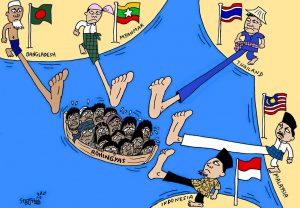th marks International Human Rights Day, some three weeks after the ASEAN Declaration of Human Rights was launched. Despite the fact that the declaration is not legally binding for their member-state signatories, it is still nonetheless lauded as a necessary first step forward for a region that has for long been known as a club of dictators. However, many too have pointed out the ambiguities and noticeable escape clauses in some of the key parts of the declaration. They reveal longstanding points of contention, if not outright obstacles, that citizens of the region will face in demanding a more just and equitable state of affairs. There is much at stake here: as the region becomes more and more integrated, so too will we see more economic deregulation and compromises in environmental safety, migrant welfare and labour security, among other things. The declaration then, for Malaysians and other Southeast Asians alike, stands ambivalently as both a point of departure and critique to inform future action. It is timely then to revisit the document to review some of the latent issues and questions therein. The contentious articles or principles they are related to are italicized, while their questionable parts are highlighted in bold: 1. Universal and local tensions Article 7: “All human rights are universal, indivisible, interdependent and interrelated. All human rights and fundamental freedoms in this Declaration must be treated in a fair and equal manner, on the same footing and with the same emphasis. At the same time, the realisation of human rights must be considered in the regional and national context bearing in mind different political, economic, legal, social, cultural, historical and religious backgrounds.” Observers are concerned because saying that rights should be “considered” in national, religious and cultural contexts can easily mean that they should also be restricted on the very basis of those contexts. Malaysians are all too familiar with this move, as citizens of an authoritarian government that has justified the curbing of rights on the basis of Asian or Islamic values for the past three decades. Must human rights be foreign or hegemonic? No. Considering differences does not mean eradicating them: it just means that the process of mainstreaming human rights must engage with local actors, from the ground below who are most aware of the contexts, policy makers, history, languages and particular issues affecting a given country. These are the groups of people and organizations who are most informed of who the human rights victims are and why, the legislation that needs reforms, the rights-friendly interpretation of religion that is most context sensitive and so forth. Underlying the issue is not a struggle between Western / foreign values against Islam or Asia but the open or closed, complex or straightforward, consultative or dictatorial nature of ensuring how rights can be more integrated into laws. 2. Balancing individual and community needs Article 8: “The human rights and fundamental freedoms of every person shall be exercised with due regard to the human rights and fundamental freedoms of others. The exercise of human rights and fundamental freedoms shall be subject only to such limitations as are determined by law solely for the purpose of securing due recognition for the human rights and fundamental freedoms of others, and to meet the just requirements of national security, public order, public health, public safety, public morality, as well as the general welfare of the peoples in a democratic society.” There are two problems with this clause, which is the first out of two occasions where the word “limitation” is used. The first problem is that general “public concerns” is privileged as a potential pretext to override individual freedoms. Secondly, it conflates too many issues at once. Surely, “public morality” is not to be weighed beside the individual in the same way as “national security” or “public safety” might. Furthermore, to include “public order” as a reason to curb individual freedoms harks back all too easily to authoritarian justifications for disregarding basic civil liberties, the examples of which Southeast Asia are not lacking. Narcissism is never good. One cannot feel free to burn garbage or torture animals on one’s land, even if it is private property. Wanton freedom is not what rights are about. Indeed, it is precisely because morality is not private that we are compelled to care for others. But the solution to individual errors is not the summoning of state power. The goal is to find a common good, whereby innocent individuals and minorities are protected from harm. Rights should never be recourse for the already strong state to solidify its punitive tendencies. 3. Why so many mention of national laws? The ASEAN Declaration of Human Rights mentions national laws a total of 4 times. It is mentioned only once in the Universal Declaration of Human Rights. The Vienna Declaration, which is a far longer document mentions national laws a mere three times. When national laws are not mentioned explicitly they are nonetheless implied. Often they are added to qualify rights. Consider the example of the second statement of article 19 that discusses the right to dissolve a marriage: “Men and women of full age have the right to marry on the basis of their free and full consent, to found a family and to dissolve a marriage, as prescribed by law.” Consider the article that deals with marriage in the Universal Declaration of Human Rights, which is more forthright in its commitment to equality: “Men and women of full age, without any limitation due to race, nationality or religion, have the right to marry and to found a family. They are entitled to equal rights as to marriage, during marriage and at its dissolution.” The Universal Declaration makes equal rights to divorce unconditional, whereas the ASEAN declaration makes it subject to what law prescribes. For all intents and purposes this can only mean national law, and this brings Malaysian Muslim women back to square one, where she stands at a disadvantage against a male-centric Shariah institution. Qualifying that certain rights are subject to national laws also has a particularly damning effect for workers, especially migrant workers. To see this we will have to look at articles 27 (1) and (2): “(1) Every person has the right to work, to the free choice of employment, to enjoy just, decent and favourable conditions of work and to have access to assistance schemes for the unemployed.” “(2) Every person has the right to form trade unions and join the trade union of his or her choice for the protection of his or her interests, in accordance with national laws and regulations.” Having just and favourable conditions of work depends on workers having a voice. That is more likely to happen when workers organize, and that organizing is most fruitful when it takes the form of unions. But what the clause, taken together, basically says is that ultimately workers can only unionize insofar as national laws permit. In other words, the only have as many rights that are allowed by the state they work in. Put in context, this article means nothing to the millions of migrant workers in Malaysia who -already with little political significance – are forbidden by law to unionize, many of whom are also from other Southeast Asian countries. Nowhere is the anti-union sentiment underlying the document clearer than in the absence of any mention in the declaration about the freedom of association. This is not the only instance where the declaration privileges the interest of member-state regimes ahead of inalienable rights. The clause following the above two says: “ASEAN Member States should also set age limits below which the paid employment of child labour should be prohibited and punished by law.” 4. Vague or cohesive? As one reads further it becomes clear that there is a great deal of vagueness in how this Declaration is to be really upheld. Article 40 expresses this conundrum: “Nothing in this Declaration may be interpreted as implying for any State, group or person any right to perform any act aimed at undermining the purposes and principles of ASEAN, or at the destruction of any of the rights and fundamental freedoms set forth in this Declaration and international human rights instruments to which ASEAN Member States are parties.” The question is raised as to who ultimately is to be accountable for human rights violations in the region. The key principle of ASEAN, after all, is non-interference and yet the document itself is supposed to be universal, binding all human beings to a shared moral code. Thus the question must be asked: what if upholding certain rights will clash with an ASEAN principle? More interestingly not all ASEAN member states are party of the same treaties and conventions (for example, Malaysia, unlike Thailand and Indonesia, has not ratified ICERD). Thus the above clause can be read to all at once criticize certain controversial policies on the basis that they violate human rights, or justify silence or indifference on the basis of non-interference. 5. The marginal remain invisible Article 2 reads as follows: “Every person is entitled to the rights and freedoms set forth herein, without distinction of any kind, such as race, gender, age, language, religion, political or other opinion, national or social origin, economic status, birth, disability or other status.” Two key omissions are noticeable from the onset: that of the LGBTQ community and the indigenous. While they can qualify as being of “other status”, the aforementioned four points easily shows that they may not be completely protected. Moving forward? Civil society organizations were not consulted in the process of forming this declaration: neither the draft of the document nor terms of reference were distributed for stakeholder insights and inputs beforehand. All things considered it is reasonable to conclude that much can remain the same, and rhetorical, until the above issues and discrepancies are dealt with. Ahmad Fuad Rahmat is managing editor for www.projekdialog.com and research fellow for the Islamic Renaissance Front.
]]>



